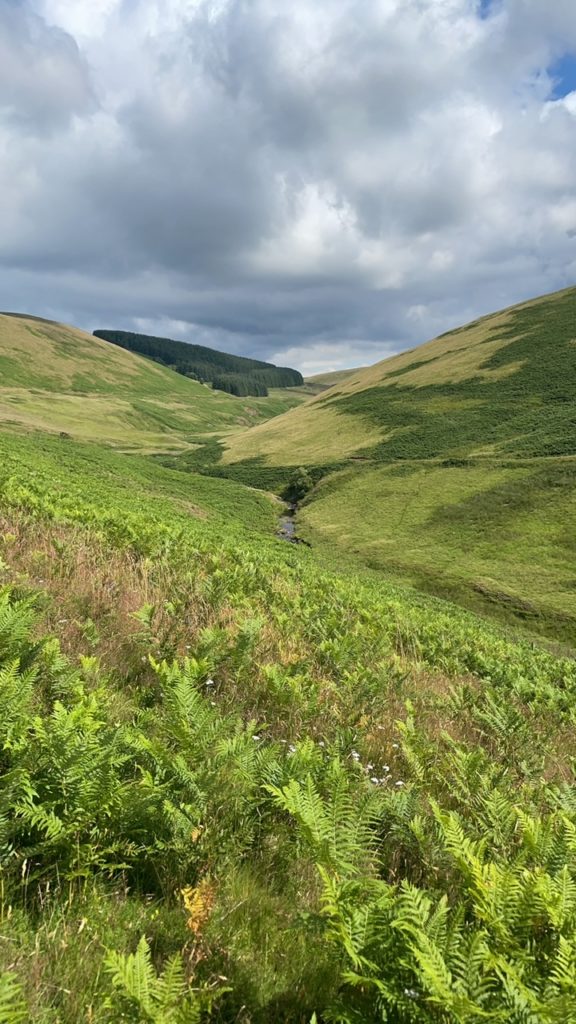The Cheviot Campaign – M Blakey
Submitted by: Sally Brewis - 16th December 2021
It was in 1979 that the United Kingdom Atomic Energy Authority became interested in our part of the world. There was a problem. Quantities of highly radioactive waste were piling up and the AEA did not know what to do with it. One suggestion was to bury it in granite rock providing that the granite was in a large unfractured mass and in a suitably obscure part of the country. A number of sites had been identified including two in the Cheviots – one at Uswayford and the other at Threestone Burn. Planning applications were made to Alnwick and Berwick District Councils for permission to carry out test drilling in these areas.

At a public meeting, the people of Rothbury and Wooler declared their opposition to any form of nuclear dumping, drilling or anything else to do with the waste and banded together under the leadership, respectively, of Dr. Bernard Richardson and farmer Anthony Murray. No, no! Said the AEA, the application was only to carry out a scientific investigation. The drilling would be carried out by a body of “disinterested” scientists – members of the Royal Geological Society – though kindly funded by the AEA. (There was no mention of dumping in the application). Notwithstanding the peoples of Coquet and Glendale joined forces to mount the “Save the Cheviots’ Campaign”. A mighty petition was gathered and a protest march was planned for Newcastle where the petition was presented to Alan Beith MP and to other MPs and Councillors who had pledged their support.
Meanwhile both sites being in the National Park, the matter was referred to the County Council and as the administrative body, to the National Parks Committee of the Council. The Chief Officer, Tony Macdonald, advised his councillors to reject the application. As one local farmer pointed out, so strict were planning conditions in the Park that he was not allowed to have an old inconspicuous railay wagon for storing hay for the sheep, let alone a large noisy piece of drilling machinery. The National Parks Committee under the Chairmanship of Harbottle farmer, Jimmy Coatsworth, refused permission to drill, on the grounds that it was contrary to the Act of Parliament which had created the Park, and under which the National Park Committee exercised its custodianship. The AEA went to appeal..
This decision threw the matter into the hands of Central Government, and the Minister for the Environment appointed an Inspector to carry out an Inquiry. People from Galloway who had already been through the process of a Public Inquiry on their patch of granite, came over the border to advise and support us. For the locals, fund-raising became an urgent matter. In addition to the usual coffee mornings, raffles and dances, musicians Alistair Anderson and friends, and the group Lindisfarne with Rod Clements held concerts, and film star Julie Christie joined the Easter walk from Wooler to Threestone Burn to raise public awareness onto a national level.
In October 1980, legal battle commenced at County Hall, Newcastle. All sorts of people came from far and near to say their piece and to face the charming, but formidable, Queen’s Counsel for the AEA, Lord Silsoe. Day after day, Bernard Richardson and Anthony Murray led their troops to Newcastle to listen to the debate, and to show their presence as a token of local concern.
Particularly to be remembered were the young scientist from the north who had discovered an unknown creature (small, it is true) in the waters of the Cheviot bogs; Jeanette Dagg who had felt the tremors of an earthquake at Milkhope; Helen Richardson, peaceably doing her crochet but never missing a point; and Jimmy Miller from Rothbury who tried to explain why local folk didn’t believe the assurances of the AEA that “they only wanted to investigate the rock”, and told the tale of the poacher with the salmon at the Thrum who, when confronted by the bailiff, professed “only to be helping the fish over the falls”.
The most telling witness of all was DR. Robson, lecturer in Geology at Newcastle University and some-time resident in Harbottle.
A great deal hinged upon the integrity of the granite bedrock. It had to be free of fractures and schisms, so that water could not percolate through the strata and gain access to the buried canisters (by this time, consideration was being given to the canisters being buried), thus causing chemical disintegration of the protective shield and allowing radioactive substances to seep out into the natural water sources of the Coquet and Glendale valleys.
It appeared than an Indian student, desirous of attaining a PhD., had chosen this very subject – the Cheviot granite, as his topic of research His subsequent thesis, lying in the archives of the University’s Geology Department, showed that certain crystallisation had taken place in the fissures of the rock formation which demonstrated that minerals in solution had been carried through the strata, and deposited just where the student had found them.
After several weeks the Inquiry closed and the Inspector returned to London to consider the evidence. Then one day, to our delight and surprise, the Minister of the Environment issued a statement: he thanked the Inspector for his report, but had decided not to pursue the matter further, at present.
There were cheers all round. The hope is that this chapter is closed not only for the present, but for all time.



